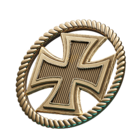German Navy Collection
The "German Navy" Collection was available during update 0.9.7 to mark the introduction of German aircraft carriers, part 2.
The overall collection comprises of six sub-collections. Each sub-collection grants a different reward. There is a separate reward for obtaining all 36 items.
Contents
Sub-Collections
Aircraft
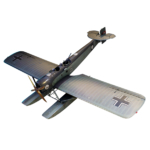
One of the first aircraft models developed by Ernst Heinkel's company was the monoplane floatplane He 1. The Reichsmarine ordered ten such aircraft in 1923. Due to limitations imposed by the Treaty of Versailles, the order was made in secret and with the assistance of Sweden.
The He 1 was the first German naval aircraft built since the end of World War I.
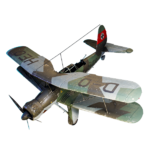
In 1935, development of an aircraft carrier project was already in full swing in the offices of the Kriegsmarine.
Arado was the company assigned to create a carrier-based reconnaissance torpedo bomber for the project. In the autumn of 1936, a prototype was ready—the Ar 95 biplane. Later, when it was decided to develop more advanced models for the future aircraft carrier, the Ar 95 (which, at that point, was in the form of a seaplane) was offered for export.
A number of such aircraft took part in the hostilities in the Baltic as part of Luftwaffe units during World War II.
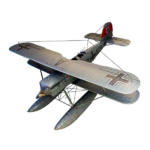
In the early 1930s, Heinkel was ordered to develop a new reconnaissance seaplane suitable for launch from a catapult. The result was the He 60 biplane, which completed its test flight in early 1933.
The plane demonstrated fine flying qualities, but was not able to bear serious loads. Its armament was limited to only one machine gun.
Production of these aircraft continued until 1937, and they participated in World War II until 1943, albeit mostly playing second fiddle.
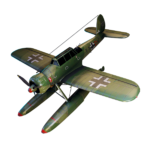
A bid for the development of a new reconnaissance seaplane to replace the obsolete He 60 for the Kriegsmarine was announced in 1936. In 1937, the bidders underwent various tests, and the winner was a monoplane designated "Ar 196", developed by the Arado company.
In 1938, the first ship to take the new aircraft aboard was the armored Admiral Graf Spee. The extremely successful and well-armed Ar 196 became the most-produced German seaplane of its time.
During the war, these aircraft were used all the way from the Arctic to the South Atlantic, and were deservedly known as the "eyes of the Kriegsmarine".
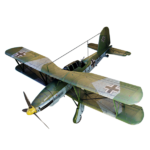
Shortly after the laying down of aircraft carrier A, which took place in late 1936, a bid for the development of this carrier-based multipurpose aircraft was announced. Victory was awarded to the company of Gerhard Fieseler, an ace of the World War I era.
His biplane, the Fi 167, which took off in the summer of 1938, exceeded all expectations and was sent to serial production with very few modifications. However, in May 1940, the construction of aircraft carrier Graf Zeppelin, for which the aircraft was intended, was suspended.
The first and, as it turned out, sole series of Fi 167s that was manufactured, was used for various tests.
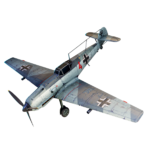
The fighter wing of the Kriegsmarine's future aircraft carrier comprised the legendary Messerschmitt Bf 109, redesigned to take off from the ship's deck. The technical design of the carrier-based fighter, designated "Bf 109T", was completed in early 1939.
Production, launched in the same year, was suspended shortly after Graf Zeppelin's construction was halted. However, a little later, a series of Bf 109Ts, adapted for aerodromes with short take-off strips, was released. Aircraft of this model participated in hostilities in Northern Europe.
Reward
Completing this sub-collection provides the following reward:
| Icon | Notes |
|---|---|
 |
Custom color schemes for the camouflages of all German destroyers |
Ship Emblems
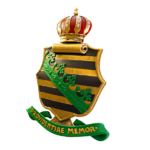
One of the five Kaiser-class battleships was named in honor of the King of Saxony, Albert (1828–1902), a participant in several military campaigns, and field marshal of Prussia and Saxony.
The ship's solemn launching ceremony on April 27, 1912, was attended by Albert's nephew, Frederick Augustus III, the last king of Saxony.
The stem of this "royal" dreadnought carried a family crest of the Saxon House of Wettin — a black and gold shield with a stylized rue branch.
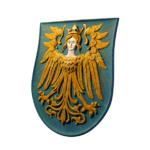
Three German cruisers carried the name of the old Bavarian city of Nuremberg. The bow decoration of the first Nürnberg, commissioned in April 1908, included both coats of arms of the city—one big, one small.
The drawings of both date back to the 13th century. The third cruiser of the same name, launched in 1934, had an emblem that contained only the big coat of arms, with its central element being the image of the mythical harpy.
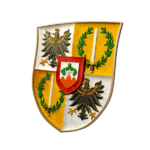
The Kriegsmarine's first battleships, Scharnhorst and Gneisenau, were named in honor of the armored cruisers of Admiral Spee's squadron that were destroyed in the battle of the Falkland Islands in December 1914.
Those, in turn, carried the names of two Prussian military leaders from the Napoleonic Wars—Gerhard von Scharnhorst (1755–1813) and Count August Neidhardt von Gneisenau (1760–1831). Both the Kaiser's cruisers and the Kriegsmarine's battleships "inherited" the family crests of the commanders that were placed on their stems.

The German city of Karlsruhe is relatively young, having been founded a little more than 300 years ago, in 1715, by Charles III William, Margrave of Baden-Durlach, as the new capital of his possessions.
On the same occasion, the Margrave established the House Order of Fidelity. The city's coat of arms is the inverted crest of Baden—a golden shield with a red ribbon. The city's emblem also includes the motto of the House Order of Fidelity—Fidelitas (the Latin for "Fidelity").
When the first German cruiser named Karlsruhe was commissioned in January 1914, her emblem exactly replicated the coat of arms of the city of the same name.
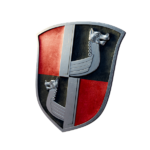
On June 14, 1936, the Naval Shipyard in Wilhelmshaven received the order to construct Battleship G. On November 2 of the same year, the official laying down of the ship took place. Twenty-nine months later, the solemn launch ceremony followed.
The godmother of the battleship named after the famous Alfred von Tirpitz was the granddaughter of the grand admiral. The ship's stem was decorated with a black, white and red emblem depicting two drakkars, symbolizing the "oceanic" ambitions of Germany's naval forces.
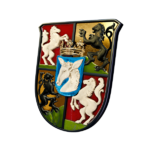
Count Ferdinand von Zeppelin's fascination with aeronautics began when he first flew in a hot air balloon as a German military observer in the American Civil War.
Having retired from the army in 1891 with the rank of lieutenant general, he entirely devoted himself to the development of airships. In 1912, the first airship of his design was purchased by the German fleet. During World War I, all over the world, any German airship was called a "zeppelin" without distinction.
Decades later, at the launching ceremony in December 1938, the Count's crest was placed on the stem of the first German aircraft carrier.
Reward
Completing this sub-collection provides the following rewards:
| Icon | Notes |
|---|---|
 |
Custom color schemes for the camouflages of all German cruisers |
Military Decorations of Germany
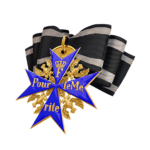
The highest and most honorable military award of the Kingdom of Prussia, and then of the German Empire until 1918, was the Order of Pour le Mérite (French for "For Merit"). It was established by Frederick the Great in 1740, when French was the language of diplomacy and the royal courts.
Ironically, many of those who received their blue cross were awarded it for the victory over the French. Pour le Mérite was awarded to high-ranking military commanders, and it was only during World War I that exceptions were made for junior officers who had demonstrated outstanding heroism, including the legendary ace pilots Manfred von Richthofen and Erich Loewenhardt.
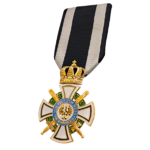
The Hohenzollern dynasty ruled in Germany until the revolution of 1918. On January 18, 1851, the day of the 150th anniversary of the coronation of the first Prussian king, the Royal Order of the House of Hohenzollern was established. Its motto stated: "Vom Fels zum Meer" (German for "From the Cliffs to the Sea").
The award was given to both military personnel and civilians. However, the badge of the Order received for military merits had some distinctive features—swords were added to the cross with the crown, and it was worn on the same ribbon as the famous Iron Cross.
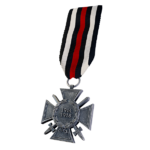
In July 1934, a special award for participants in World War I—20 years after its commencement—was finally introduced in Germany.
The decree on the establishment of the Honor Cross of the World War 1914/1918 was signed by one of the heroes of that war—President of the Republic, Field Marshal Paul von Hindenburg—shortly before his death. Very quickly, the people nicknamed the award the "Hindenburg Cross".
It was awarded both to war veterans, who received a cross decorated with swords, and the widows or parents of those who had fallen in battle.
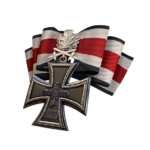
The best-known German military order, and one of the symbols of German military glory, is definitely the Iron Cross, which was established in 1813 during the war against Napoleon.
Any military servant, regardless of their rank or position, could be awarded the order for their merits in battle. The Iron Cross was awarded for acts of heroism shown during one of the four wars in which Germany participated in the past two centuries. The date on the cross—1813, 1870, 1914, or 1939—indicated which one.
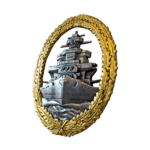
In the midst of World War II, the Kriegsmarine Military Command instituted special insignia for the crews of ships of various types that took part in military operations.
In April 1941, the High Seas Fleet War Badge was introduced for crew members of battleships and cruisers. Its impressive design—a silhouette of a large warship in a gilded wreath of oak leaves—made the badge one of the most recognizable awards of the Kriegsmarine.
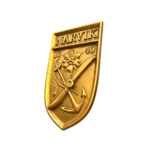
The Battle of Narvik, which lasted from April to June 1940, was one of the most notable events of World War II.
In 1941, an insignia—a special shield-shaped decoration worn on the left sleeve—was introduced for those who took part in this battle. Besides the inscription which read "Narvik 1940", the shield had an anchor, a propeller, and an edelweiss flower, symbolizing the navy, aviation, and mountain troops, respectively.
The majority of decorations—over 3,500—were awarded to military sailors, most of whom were crew members of the ten Kriegsmarine destroyers sunk at Narvik.
Reward
Completing this sub-collection provides the following rewards:
| Icon | Notes |
|---|---|
 |
Custom color schemes for the camouflages of all German battleships |
Personalities
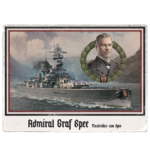
Vizeadmiral Maximilian, count von Spee (1861–1914), rose to fame during World War I as the commander of the East Asia Squadron of cruisers. With the outbreak of hostilities, Spee was caught far away from the main bases and, together with his detachment, made an unprecedented crossing of the Pacific Ocean, skillfully avoiding any encounters with the British, Japanese, and Australian ships hunting him down.
In November 1914, he defeated a British squadron in the Battle of Coronel. In December of the same year, the admiral perished together with his flagship, Scharnhorst, in the Battle of the Falkland Islands.
In January 1936, armored ship Admiral Graf Spee, named after him, joined the German Navy.
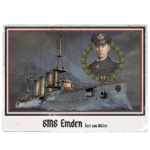
Kapitän zur See Karl von Müller (1873–1923) left his mark on history as the commander of cruiser Emden—the most successful raider of World War I. Emden caught his first "prey" the very next day after having received the news of the commencement of hostilities.
Then, due to the careful planning and intuition of her commander, the raider spent the next two months terrifying enemy ships in the Indian Ocean. She extremely swiftly and stealthily navigated the open seas and struck her enemies when they least expected it. One Russian cruiser and one French destroyer became her victims, and more than twenty transport vessels her captives.
In November 1914, Emden was destroyed when she faced off against a faster and better armed Australian ship. Von Müller was taken prisoner, but later tried to escape. He managed to make it back home—a national hero by then—only when the war was drawing to an end.
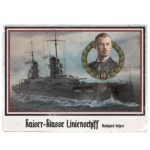
Admiral Reinhard Scheer (1863–1928) came to prominence as the commander of the German fleet in the Battle of Jutland.
In January 1916, at the height of World War I, Scheer was assigned as the Head of the High Seas Fleet—the main force of the Imperial Navy. The admiral raised his flag aboard Friedrich der Große, a Kaiser-class battleship. Being a dedicated follower of strict discipline, Reinhard Scheer's preferred naval strategy was aggressive warfare that utilized all available means to destroy the enemy, including air and underwater strikes. He was in command of the German forces during the largest battle of dreadnought battleships—the Battle of Jutland. The precise maneuvers of Scheer's fleet, with his ships operating like a well-oiled machine, enabled the Germans to inflict greater losses on the enemy and avoid the trap that the superior forces of the British Grand Fleet had laid for them.
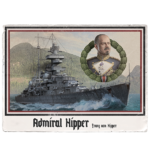
Franz von Hipper (1863–1932) was an admiral in the German Imperial Navy (1918). In 1913, Hipper distinguished himself when he commanded the I Scouting Group, consisting of powerful high-speed battlecruisers.
Hipper's Squadron took part in the two largest naval battles of World War I—the Battle of Dogger Bank in January 1915, and the Battle of Jutland in May and June 1916.
Owing to the admiral's decisive and skillful actions, as well as the impeccable accuracy of his cruisers when firing, the reconnaissance forces of the High Seas Fleet gracefully managed to cope with any situation, even when facing more powerful opposition. The most painful losses of the British during the Battle of Jutland—three battlecruisers—were caused by Admiral Hipper's squadron.
In April 1939, Admiral Hipper, the lead ship in a series of five heavy cruisers, joined the German Navy.
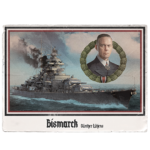
Admiral Günther Lütjens (1889–1941) went down in history as the man who led the first, and only, voyage of battleship Bismarck, although he also took part in other significant military operations over the course of his career.
At the beginning of World War II, Lütjens was appointed as commander of the Kriegsmarine's Scouting Forces. He led a raid to the shores of Great Britain, then, having raised his flag over battleship Gneisenau, covered the landings in Norway. In the summer of 1940, the admiral was assigned the post of commander of the fleet.
Impermeable and a man of few words, but unreservedly devoted to his duty, Lütjens enjoyed an impeccable reputation among his superiors and unquestioned authority among his subordinates.
From January through March 1941, in command of a formation of Scharnhorst-class battleships, he carried out a successful raid in the Atlantic and caused serious damage to British communications. In May of the same year, the admiral raised his flag over a brand new battleship, Bismarck, and made a fresh attempt to break through to the ocean—a venture that turned out to be fatal for him.
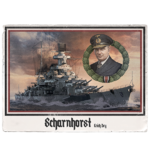
Erich Bey (1898–1943) dedicated nearly all of his career to serving on destroyers. However, he engaged in his final battle with his flag hoisted over battleship Scharnhorst.
During the early stages of World War II, Bey commanded a flotilla of destroyers and took an active part in combat operations in this capacity. He was one of the heroes of the Battles of Narvik, during which, in April 1940, while cut off from any supplies in the narrow fjords, his German destroyers desperately fought against British ships until the last shell had been spent.
In December 1943, Konteradmiral Bey led battleship Scharnhorst in a campaign against Allied convoys in the Arctic. The British, who possessed more advanced radars, concentrated all their available forces to detect, surround, and finally destroy the raider in the Battle of North Cape. Erich Bey perished together with his ship. The skill and perseverance demonstrated by the admiral during his final battle was cited as exemplary by the British military command.
Reward
Completing this sub-collection provides the following rewards:
| Icon | Notes |
|---|---|
 |
A second flag on all German destroyers |
Ships
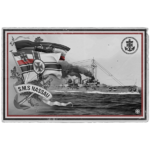
The first German dreadnought battleship, named after a region in the west of Germany, was commissioned in October 1909. The design work for the ship began in 1903. By early 1905, the project had the features of a ship with uniform main battery guns.
Information about battleship Dreadnought being built in the U.K. motivated the German Empire to come up with an adequate response. In the summer of 1907, the laying down of the first four German dreadnoughts took place, and less than 3 years later, all of them became part of the nation's navy.
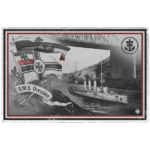
Cruiser Dresden, laid down in 1906 and named after the capital city of Saxony, was built as an experimental ship in some ways. She was one of the first capital warships of the Kaiser's navy to be equipped with steam turbines.
Her sister ship, the legendary Emden, had a more archaic propulsion system—triple-expansion steam engines. Both cruisers entered service between 1908 and 1909. During World War I, both ships joined the East Asia squadron commanded by Admiral von Spee, and both perished in battle against British ships.
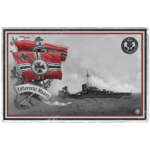
Commissioned in January 1937, Leberecht Maass became the pioneer of the majority of Kriegsmarine's destroyers. The six series of ships that followed basically repeated the primary specific features of their prototype—the size, outline profile, arrangement, and type of propulsion.
The destroyer was named after an admiral who perished in the Battle of Heligoland Bight in 1914. The operational record of Leberecht Maass was short—in February 1940, the destroyer exploded and sank after hitting a British mine.
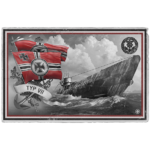
Type VII U-boats were the most common ships of this type. Over the period of a decade, between 1935 and 1945, more than 700 Type VIIs were built.
During World War II, these very submarines became the most dreaded and effective weapon of the Kriegsmarine. Relatively small, with a displacement of around 800 tons when submerged, and with a crew of below fifty men, they terrified the warships and cargo ships of the Allies wherever they appeared.
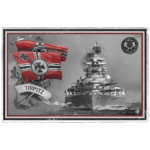
Time after time, Britain made strenuous efforts to destroy this formidable German battleship, which never encountered enemy ships in battle.
In November 1944, as the result of a raid by British bombers carrying super-heavy 5.5-ton bombs, the battleship was finally sunk. Heinrich Ehrler—an ex-fighter ace and holder of the Knight's Cross of the Iron Cross with Oak Leaves—was responsible for the AA cover of the ship. For his failure, he was put on trial and sentenced to capital punishment, which was later reduced to imprisonment in a fortress.
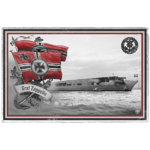
With every chance of becoming the Kriegsmarine's sole full-fledged strike aircraft carrier, Graf Zeppelin was built twice.
The first time, construction on the imminently-ready ship ceased in the spring of 1940—the ship's artillery was sent to defend Norway, which had been occupied shortly beforehand, and the gun fire control system was sold to the U.S.S.R. However, the Taranto Raid, air attacks on Bismarck, and finally the attack on Pearl Harbor made a strong impression on the Kriegsmarine command, and they decided that Germany needed an aircraft carrier of its own.
Two years of desolation later, in the spring of 1942, work on the ship resumed, but then ceased again at the beginning of the next year, when the naval strategy changed. Surface warship forces were completely removed from the Third Reich's shipbuilding priorities.
Reward
Completing this sub-collection provides the following rewards:
| Icon | Notes |
|---|---|
 |
A second flag on all German cruisers |
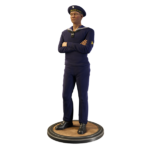
The Imperial German Navy, or Kaiserliche Marine, was established in 1871 following the unification of the country and the creation of the German Empire.
For the first two decades, the German Navy played a relatively modest role in Europe, their primary goals being the maintenance of the nation's prestige and provision of coastal defense. By 1888, the year of Emperor Wilhelm II's ascent to the throne, the personnel of the Kaiserliche Marine comprised slightly more than sixteen thousand sailors and officers.
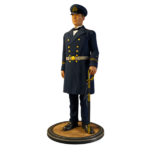
A turning point in the history of the Imperial German Navy came in 1898 when, shortly before being appointed as Secretary of State of the German Imperial Naval Office, Admiral Alfred von Tirpitz submitted a draft project for the development of the country's naval forces to the Emperor.
The Tirpitz Plan was intended as nothing more than a confrontation with Great Britain, the leading naval power in the world. In 1914, after 15 years of intensive warship construction, Germany was capable of sending a fleet out to sea with a total tonnage of over one million tons.
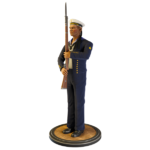
After the defeat in World War I, in accordance with the conditions of the Treaty of Versailles, the German navy was in fact returned to its "initial state" of coastal forces. The country was allowed to preserve a handful of old ships.
The personnel of the Navy of the German Republic, the Reichsmarine, was limited to 15,000, which was the level of the German Navy during the 1880s. The years of hard work that followed were aimed at training specialists and maintaining the shipbuilding industry at an adequate technological level.
The new phase of naval development started in 1935, when the Kriegsmarine was founded as the naval force of the Third Reich.
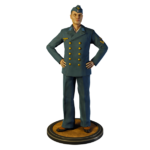
A senior seaman, or Obergefreiter, of the Kriegsmarine in naval duty uniform. For convenience, when carrying out work on the deck or around the guns and mechanisms, the Schiffchen-type side cap was introduced in 1938, and was worn both by officers and sailors. It was most often seen aboard U-boats where it turned out to be the most practical.
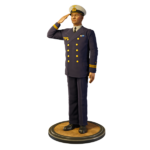
Oberleutnant zur See in his "light" duty uniform—a dark double-breasted jacket without shoulder marks, and a summertime peaked cap.
The duty uniform of the Kriegsmarine's officers differed in just a few details from the uniform of the Imperial German Navy's officers.
Crowns disappeared or were replaced with stars, Third Reich insignia were introduced, and the stand-up collar gave way to a turn-down collar.
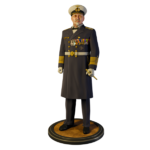
The full dress, or parade military uniform, of the Kriegsmarine's officers had several variants. It could be worn with shoulder marks made from curl cord, or archaic-but-still-accepted epaulets.
Depending on the level of dignity of the occasion, the decorations were worn either in their full size, or were replaced with a medal ribbon bar. The belt could be either a white parade belt or a dark repp belt. The parade uniform was often worn together with bladed weapons—a dagger as a rule.
However, in certain cases, especially when wearing the epaulets, admirals were supposed to hang an officer's sword on their belts.
Reward
Completing this sub-collection provides the following rewards:
| Icon | Notes |
|---|---|
 |
A second flag on all German battleships |
Overall Reward
Completing the entire collection provides the following rewards:
| Icon | Name | Notes |
|---|---|---|
 |
Second flag | A second flag on all German aircraft carriers |
 |
Camouflage color scheme | Custom color schemes for the camouflages of all German aircraft carriers |
